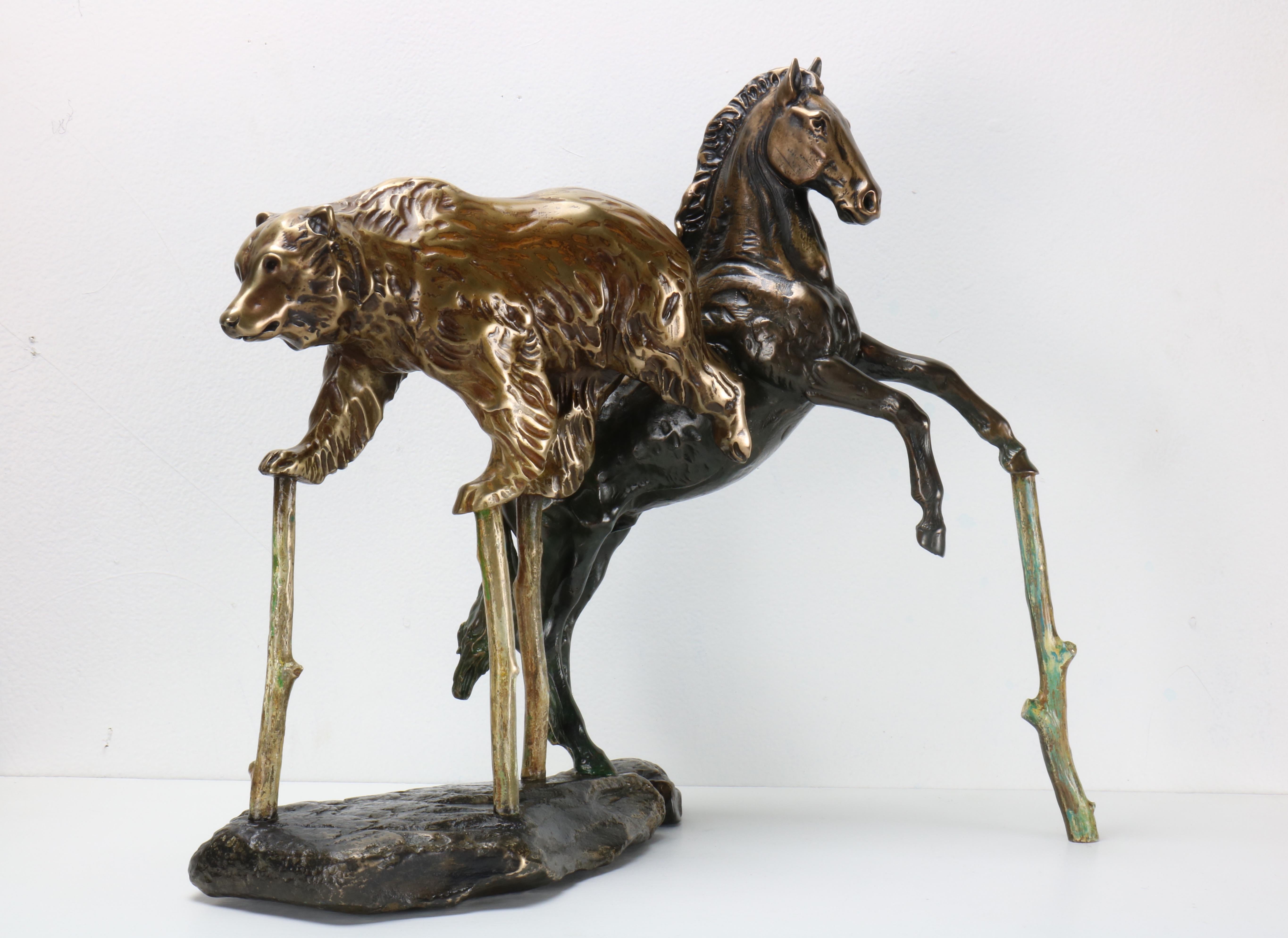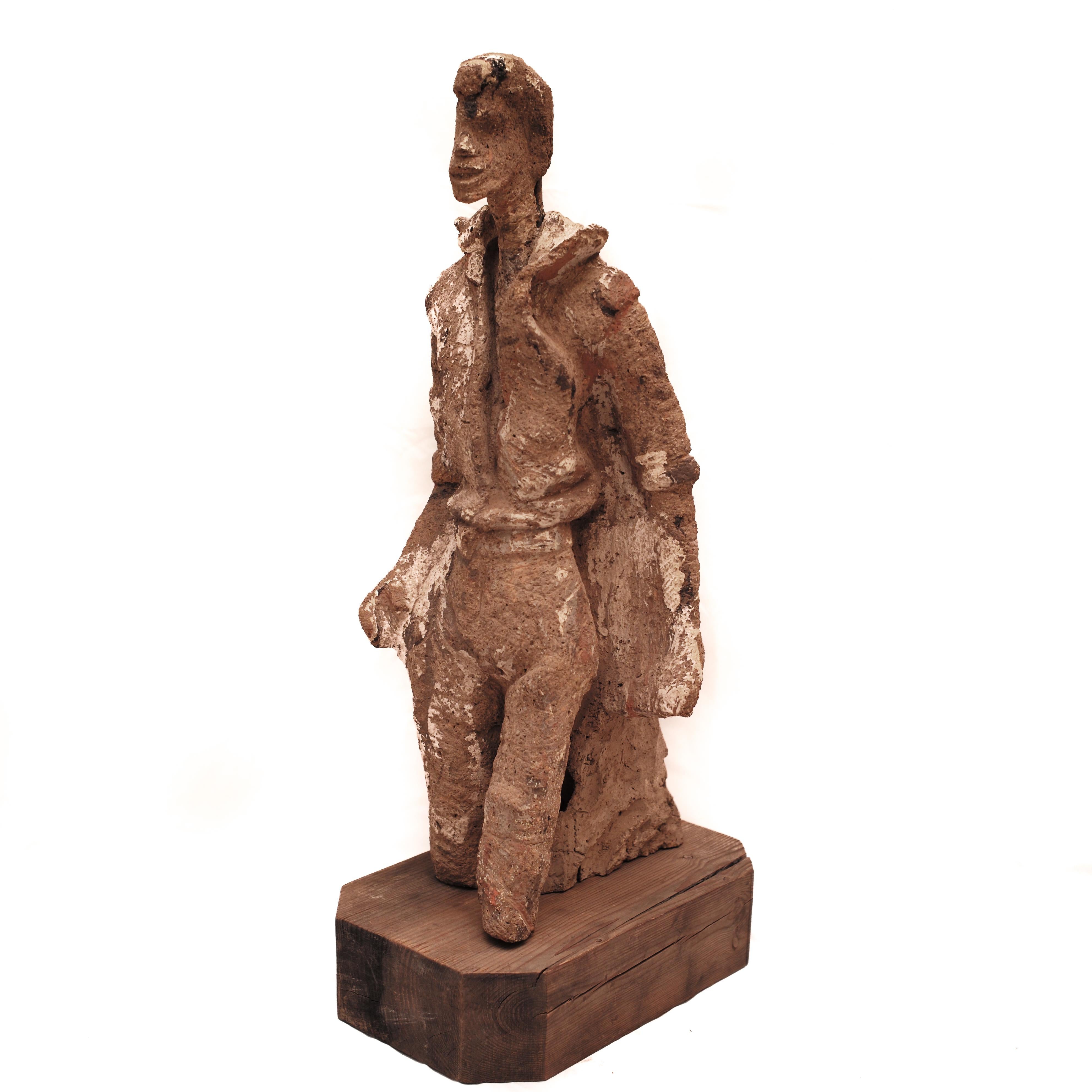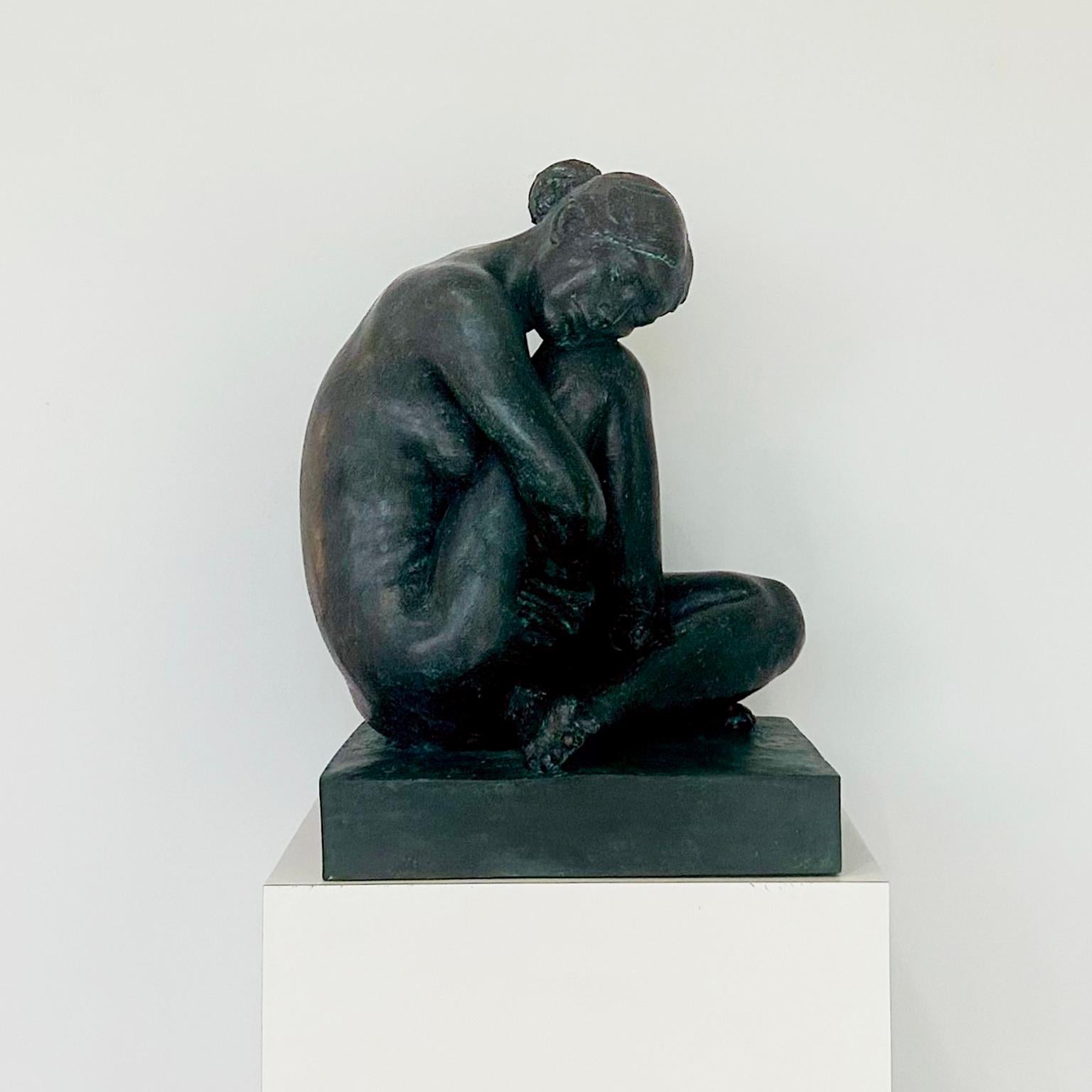Items Similar to Tête de cariatide Head of Caryatid
Want more images or videos?
Request additional images or videos from the seller
1 of 8
Amedeo ModiglianiTête de cariatide Head of CaryatidConceived in 1910
Conceived in 1910
About the Item
Amedeo Modigliani
1884-1920 Italian
Tête de cariatide
Head of Caryatid
Signed “Modigliani” and numbered “1/8” (near base)
Bronze
The figural works of the iconic modernist Amedeo Modigliani are known for their instantly recognizable style, and they are among the most coveted in the world of art collecting, with Modigliani ranking among the world’s ten most valuable artists of all time. This monumental bronze, conceived by the artist in 1910, demonstrates his mastery of sculpture. Sculpting was the artist’s self-proclaimed first and true passion — a fact sometimes overlooked due to the success of his paintings and the overwhelming rarity of his sculptures. His famed Tête series from which this bronze hails stands as his most important sculptural output, with works recognized for their timeless quality and strong, stoic presence. Tête de cariatide reflects these qualities and provides a compelling glimpse into Modigliani’s greatest artistic passion.
This bronze is an enlarged casting of a wooden sculpture — the only known sculpture that Modigliani carved in wood rather than stone. Commissioned posthumously by Modigliani’s daughter Jeanne alongside the Modigliani Institute, the bronze iteration here perfectly captures the rich woodgrain texture of Modigliani’s original carving and retains its careful compositional balance. Soulful and intense, it reflects the exaggerated yet elegant elongation of the artist’s figural paintings, which became his much sought-after signature style.
Modigliani’s interest in African and other non-Western art is well-documented. This bronze is reminiscent of a tribal mask or ancient deity, both due to its exaggerated features and the totemic appearance achieved by the work’s texture, meditative presence and sheer size. Yet the work also alludes to the artist’s Italian heritage and training. A caryatid is a staple of classical architecture, an ornate column typically found on the façade of a temple that takes the form of a female figure, with the most famous examples being on the Acropolis of Athens. The present sculpture exudes the same striking, memorable quality.
Born in Livorno, Italy in 1884, Modigliani dreamed of becoming a sculptor from a young age when he first encountered the grand marbles of Michelangelo. He moved to Paris in 1906, but it was not until 1909 after meeting modernist sculptor Constantin Brancusi that he began carving figures. For a time, he devoted himself almost entirely to sculpting, completing very few paintings between 1911 and 1914 but producing several sketches and gouaches relating to his sculptural projects. Modigliani exhibited a series of his sculptures in the 1912 Salon d'Automne.
Among the reasons Modigliani’s work is so highly sought after is the fact that the artist died at the premature age of 35, limiting his entire lifetime production to under 400 total artworks. Within that number, his sculptures are exceedingly rare; he only created around twenty-six total, most of which are held in museums such as the Museum of Modern Art (New York), the Metropolitan Museum of Art (New York) and the Tate Gallery (London). Modigliani suffered from tubercular meningitis his entire life, which ultimately limited his ability to continue to pursue the physical and laborious art of sculpting, emphasizing this bronze’s importance and rarity with the artist's oeuvre.
The other editions of this series can be found in public collections worldwide, including Morocco, Saudi Arabia and the exterior of the Casa Natale Modigliani in Rome, which houses the Modigliani Institut archives.
Conceived in 1910. Posthumous, contemporary casting circa 2006.
Bears the foundry mark of Paolo Olmeda as well as the artist’s signature and edition number “1/8”
24" wide x 34" deep x 90" high
Base: 35 3/4" wide x 45 3/4" deep x 28" high
- Creator:Amedeo Modigliani (1884 - 1920, Italian)
- Creation Year:Conceived in 1910
- Dimensions:Height: 90 in (228.6 cm)Width: 24 in (60.96 cm)Depth: 34 in (86.36 cm)
- Medium:
- Movement & Style:
- Period:
- Condition:
- Gallery Location:New Orleans, LA
- Reference Number:
About the Seller
5.0
Vetted Seller
These experienced sellers undergo a comprehensive evaluation by our team of in-house experts.
Established in 1912
1stDibs seller since 2013
15 sales on 1stDibs
Typical response time: 4 hours
- ShippingRetrieving quote...Ships From: New Orleans, LA
- Return PolicyThis item cannot be returned.
More From This SellerView All
- CoupleBy Agustín CárdenasLocated in New Orleans, LAInfused with a crisp modernity and subtle sensuality, this bronze sculpture by Cuban-born artist Agustin Cárdenas is an exceptional example of late-2...Category
20th Century Modern Figurative Sculptures
MaterialsMarble, Bronze
- Winston Churchill Artist Proof Bust by Ivor Roberts-JonesBy Ivor Roberts-JonesLocated in New Orleans, LAIvor Roberts-Jones 1916-1996 British Sir Winston Churchill Artist Proof Bronze with a green patina One of the greatest leaders of the modern world, Winston Churchill is among the...Category
20th Century Figurative Sculptures
MaterialsBronze
- Laocoön And His Sons By Adriaen De VriesLocated in New Orleans, LAAdriaen de Vries 1556-1626 Dutch Laocoön and His Sons Bronze A remarkable feat of artistry and skill, this bronze sculpture was created by famed Dutch artist Adriaen de Vries. Full of the swelling emotions and dramatic posing so quintessential to the period, the bronze is a masterclass in Baroque sculpture. The original Laocoön marble sculpture, after which this remarkable bronze was modeled, unquestionably influenced the lives and works of countless artists, authors, popes, kings and emperors since its re-discovery in 1506. Famously, Michelangelo declared the sculpture, created circa 35 BC, as the “greatest piece of art in the world.” Adriaen de Vries, an apprentice of the great sculptor Giambologna, undoubtedly sought to prove his skill and creative voice with his own depiction of this most famous scene. Known for his virtuosic casting technique, this rare and important sculpture embodies de Vries’ mastery. The story of Laocoön is one of the most famous in all of literature. As told by the poet Virgil, the Greeks, after an unsuccessful ten-year siege on the city of Troy, the Greeks craftily left a giant wooden horse outside the gates...Category
16th Century Baroque Figurative Sculptures
MaterialsBronze
- THE LAST DAYS OF NAPOLÉON BYLocated in New Orleans, LAThis highly evocative bronze by Vincenzo Vela captures the deposed Emperor Napoléon on his deathbed, holding a map of Europe and lost in thought about what might have been. Remarkable among most portrayals of the exiled leader, this highly detailed sculpture depicts Napoléon at his most vulnerable. Nonetheless, Vela perfectly captures his still-heroic bearing, which imparts to this work a monumental quality and quiet dignity. The mate to this figure is the colossal marble at the Musée du Château de Malmaison, which was shown at the Paris Salon of 1867. The founder of the verismo movement in Italy, Vela was one of the great exponents of realism in sculpture. Born in Ligornetto, Switzerland in 1820, he studied under celebrated sculptor, Benedetto Cacciatori. He was also influenced both by the work of Tuscan sculptor Lorenzo Bartolini, who seamlessly combined neoclassicism with naturalism and the romantic painting of Francesco Hayez...Category
19th Century Realist Figurative Sculptures
MaterialsMarble, Bronze
- How They Met Themselves By John Singer SargentBy John Singer SargentLocated in New Orleans, LAJohn Singer Sargent 1856-1925 American How They Met Themselves Bronze John Singer Sargent was among the most successful artists of his era. By the late 19th century, he was the m...Category
Early 20th Century Post-Impressionist Figurative Sculptures
MaterialsBronze
- Arabesque on Right Side, Right Hand Close to Earth, Left Arm OutsideBy Edgar DegasLocated in New Orleans, LAOne of a series of sculpted dancers created by the incomparable Edgar Degas, this exceptional bronze exudes all of the expressivity one expects from this 20th-century great. Degas captures the essence of his model in the graceful work, as she strikes a particularly difficult pose of the arabesque. The dancer's features have been manipulated and simplified, executed in a manner that seems almost as if one of Degas' Impressionist canvases has come to life. Degas was obsessed with capturing the dancer in motion throughout his career. He rendered their grace and movement in oil, pastel, pencil, chalk and wax - in fact, of the seventy-four wax sculptures created by Degas during his lifetime, forty of them depicted dancers. Seven of these belong to his series that capture the various forms of the arabesque, and the present work is included among them. It details one of the most difficult and animated poses of the ballet. Degas’ dancer is precariously posed in a study of balance and motion, one leg gracefully thrust into the air as she tilts her body down towards the earth and extends her arm forward. The sense of her movement is perfectly captured in the extraordinary work, as well as the fluid lines of her body. The bronze is a sought-after rarity in terms of Degas’ sculptures. Not only are his dancers the most desirable of his work, but this bronze is also distinguished by the fact that it is a Valsuani bronze, meaning it faithfully records Degas’ wax version’s pose as it appeared at the time of its creation. Most Degas' bronzes that are found on the market were cast by Hébrard – these serialized bronzes are surmoulages, or “aftercasts,” that were cast from the modèle bronzes currently in the Norton Simon Museum (Pasadena). Because these bronzes are second generation, they are smaller and far less detailed that the current bronze. This example, however, was cast by Valsuani from a plaster that was taken directly from Degas’ waxes, according to scholarship by the art historian Dr. Gregory Hedberg. These plasters were created by Degas’ sculptor friend Albert Bartholomé shortly after Degas completed his wax figurines. Thus, they record the earliest versions of Degas’ wax sculptures, before they were damaged by time or handling, and before Degas himself altered the works. The Hébrard bronzes...Category
20th Century Impressionist Figurative Sculptures
MaterialsBronze
You May Also Like
- Il Bernini - Sculpture by Ambrogio Borghi - 1884Located in Roma, ITThe bronze proposed here was initially presented in November 1878 at the Competition for the Encouragement of Brera. It is therefore one of the first celebratory works of the sculptor Ambrogio Borghi...Category
1880s Modern Figurative Sculptures
MaterialsBronze
- Show of InterestBy Brad RudeLocated in Denver, COArtist Brad Rude was born in Montana and has lived in Walla Walla, Washington most of his life. His journeys through his grandfather's folk art studio left...Category
2010s American Modern Figurative Sculptures
MaterialsEnamel, Bronze
- Combined EffortBy Brad RudeLocated in Denver, COArtist Brad Rude was born in Montana and has lived in Walla Walla, Washington most of his life. His journeys through his grandfather's folk art studio left...Category
2010s American Modern Figurative Sculptures
MaterialsEnamel, Bronze
- Contemporary Solid Bronze Nude Figurative Sculpture 'Sprite' by Benson LandesBy Benson LandesLocated in Shrewsbury, Shropshire'Sprite' by Benson Landes is a Contemporary Solid Bronze Nude Figurative Sculpture. The remarkable elegance conveyed is breath-taking and so representative of the ballet form. This ...Category
20th Century Modern Figurative Sculptures
MaterialsBronze
- Large Terracotta Sculpture by Evert Lindfors, Sweden, 1970sLocated in Stockholm, SEFor sale: A captivating terracotta sculpture from the esteemed Swedish artist Evert Lindfors (1927-2016), crafted in the 1970s. A connoisseur of fine arts, Lindfors honed his craft a...Category
1970s Modern Figurative Sculptures
MaterialsBronze
- "Untitled" bronze sculpture of seated female figure by artist Felipe CastañedaBy Felipe CastañedaLocated in Boca Raton, FL"Untitled" bronze sculpture of a female nude by artist Felipe Castañeda. Inscribed F. Castañeda 1984 P/A on base.Category
1980s Modern Figurative Sculptures
MaterialsBronze



